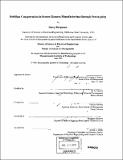Building competencies in sensor harness manufacturing through prototyping
Author(s)
Bergman, Stacy (Stacy Adele), 1972-
DownloadFull printable version (9.200Mb)
Other Contributors
Leaders for Manufacturing Program.
Advisor
Ali A. Yassine and Thomas Roemer.
Terms of use
Metadata
Show full item recordAbstract
Organizational knowledge is information about products, processes and customers that is held by the personnel in the organization. Institutionalization of the best practices contained within this knowledge is essential in creating competencies. Unfortunately, organizations do not utilize this knowledge effectively. This thesis introduces a framework that shows how establishing a prototype system to enhance product and process understanding can start to build organizational knowledge in the short-term. Along with external benchmarking, this internal knowledge can be used to form best practices based competencies. This framework will be illustrated through the use of a case study. The case study was conducted at the Delphi Automotive Systems Mexico Technical Center. The case study project was undertaken to improve the Energy and Chassis Systems division's competencies in sensor wire harness products. In order to support this competency development, the author worked with Delphi Automotive Systems personnel to develop best practices based competencies employing the competency development framework introduced in this thesis. Installation of a working prototyping system was achieved in the six-month project period. Through the production and delivery of these harnesses, internal best practices were developed. These were used along with benchmarking of other harness manufacturers to develop a baseline best practices based competencies repository for the division. Effective use of the best practices based competencies developed during the case study project should foster improvement in competitive metrics, particularly speed-to-market and product development costs. Extension of best practices based competencies development to other products will allow human and monetary capital to be released from re-engineering tasks. These resources can then be refocused on product advancement to exceed customer expectations in the automotive market. It will also allow the organization to focus resources on development of strategic nonautomotive markets in order to diversify the business to protect against future downturn in the automotive market.
Description
Thesis (S.M.)--Massachusetts Institute of Technology, Dept. of Electrical Engineering and Computer Science; and, (S.M.)--Massachusetts Institute of Technology, Sloan School of Management; in conjunction with the Leaders for Manufacturing Program at MIT, 2001. Vita. Includes bibliographical references (p. 105-115).
Date issued
2001Department
Leaders for Manufacturing Program at MIT; Massachusetts Institute of Technology. Department of Electrical Engineering and Computer Science; Sloan School of ManagementPublisher
Massachusetts Institute of Technology
Keywords
Electrical Engineering and Computer Science., Sloan School of Management., Leaders for Manufacturing Program.